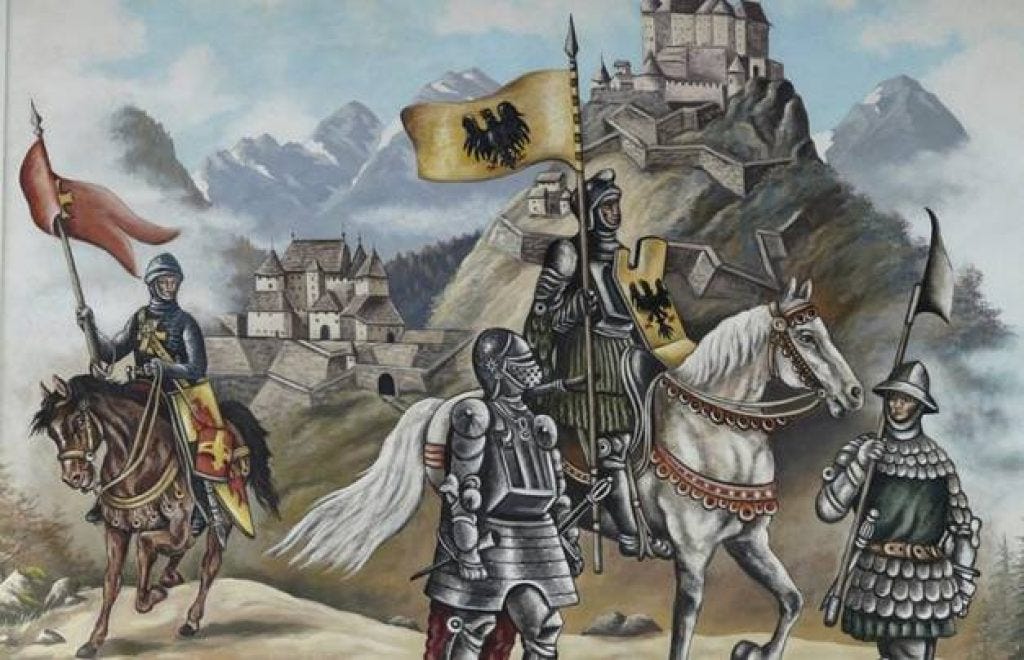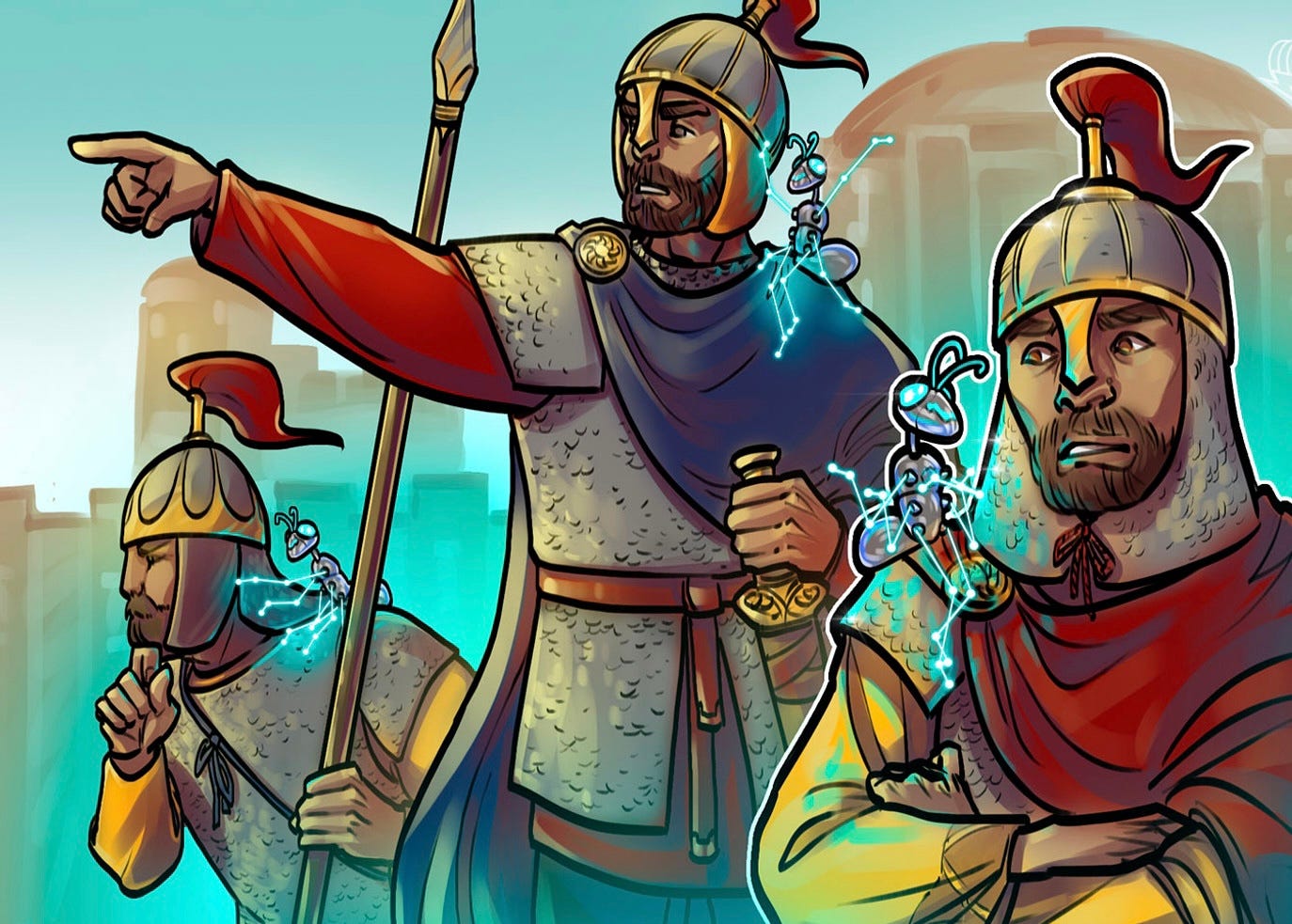The Byzantine's Generals Problem
What Bitcoin teaches us about Leadership in the digital age.
“It is not sufficient that everyone knows X. We also need everyone to know that everyone knows X, and that everyone knows everyone knows that everyone knows X”
James A Donald (anonymous Canadian cryptographer)
Today, I'm taking on a challenging topic that I find hard to explain, especially when it comes to linking its insights to leadership. This post is a bit daring because I'm worried that I might not be able to convey the mental picture I have.
I usually use this platform to explore ideas that encourage deep thinking about leadership, rather than writing lengthy and extensively researched articles. However, this time, I'm pushing myself to connect two seemingly unrelated subjects, even though there's a good chance I might not succeed.
I've become intrigued by the idea of understanding why Bitcoin and blockchain are considered technological revolutions, and this interest began when I encountered something called "The Byzantine’s Generals Problem."
I want to clarify that I'm not an expert in this field, but I'll do my best to explain...
The Byzantine's Generals problem is a thought experiment that deals with the challenge of coordinating actions between parties that may not trust each other; and this is solved by blockchain technology.
“A reliable computer system must be able to function even if one or more of its components fails. A failing component may display a frequently overlooked behavior: delivering contradicting data to different sections of the system. The Byzantine generals problem is an abstract expression of the problem of dealing with this type of failure.” (Cointelegraph)
The original research paper in computer sciences was financed by the National Aeronautics and Space Administration (NASA), the Ballistic Missile Defense Systems Command and the Army Research Office and authored by Leslie Lamport, Marshal Pease and Robert Shostak.
It was published in 1982 and it describes the situation where several involved parties need to create a consensus about their future actions. However there is the possibility that bad actors might work in a way that could cause the entire system to fail.
Trust is at the essence!
The problem is described with three (or more) imaginary Byzantine generals preparing to either attack or retreat from a city under siege. Each general has their own army, and these armies are positioned at various sides of the city to be attacked. The city is strong enough to handle a single army attacking it, maybe even two of them at the same time; but it cannot defend against all of them attacking at the same time.
The generals need to communicate with each other and ensure that their armies attack simultaneously, which is the only way the city can be conquered. Every general will send a message to the other two sharing their plan to attack. They can either come to a consensus on performing that attack or decide that they will retreat.
The key here is that they must collectively decide when to attack. If all generals attack at the same time, they will win, but if they attack at different times, they will lose.
What is critical to this experiment is that the generals have no secure communication channels with one another. Any messages they send or receive can be intercepted and corrupted by defenders of the city, which would make them act in the opposite way that was originally intended by the sender of the message.
But how can the generals organize to attack at the same time?
The Byzantine Generals Problem can also be seen as a game theory problem, which describes the difficulty decentralized parties have in arriving at consensus without relying on a trusted central party.
In a network where no member can verify the identity of other members, how can all members collectively agree on any truth?
Only decentralized systems face the Byzantine Generals problem, as they have no reliable source of information and no way of verifying the information they receive from other members of the network. In centralized systems, an authority is trusted to publish true information and prevent false claims from being spread throughout the network.
However, centralized systems do not solve the Byzantine Generals problem. Why?
Because the challenge of this thought experiment is how to establish trust without having to trust any central authority.
In the Bitcoin white paper released to the world in October 31st 2008, the author (or group of authors) under the pseudonym of Satoshi Nakamoto solves the Byzantine’s General Problem by introducing to the world blockchain technology.
What is Blockchain?
Blockchain is the foundation for Bitcoin (and other cryptocurrencies, but I'll focus on Bitcoin here). It's a bit like a digital record-keeping system, but it's not controlled by just one person or group. Instead, lots of people can work together to keep track of and confirm transactions without needing a main authority. Imagine it as a shared digital ledger that lots of folks use. The special thing is that information can't be copied, only one person can own it. For instance, if you own a bitcoin, no one else can have that exact same one.
Think about a bunch of people, the Byzantine's Generals, who want to exchange Bitcoins all around the world, even if they don't know each other. Each general has a copy of the whole blockchain, which lists every verified transaction ever done on the network.
Because the blockchain isn't controlled by just one group, there's no one weak spot that could break down the whole thing. By using decentralized networks and ways to agree, this technology offers a secure and reliable way to trade value (trust) without needing a main authority.
How to apply these insights to Leadership?
We can view the Byzantine's Generals problem as a way to understand the difficulties of leadership and decision-making in complex organizations. Just like the generals, leaders and their teams have to deal with a complicated mix of relationships, conflicting interests, and sometimes uncertain ways of communicating. They also need to identify and address negative behaviors.
Strong leadership means working together and finding common ground.
Just as the generals must collaborate to coordinate their actions for victory, business leaders have to create partnerships and unite people around a shared goal to make the organization successful.
Another connection we can make is the value of openness and responsibility to build trust and ensure that everyone works in harmony with shared goals. The Byzantine's Generals problem shows us how to handle situations when parties can't trust each other. No leader can do their job well under such conditions.
The Byzantine's Generals problem offers a helpful framework for thinking about the difficulties of leadership and decision-making in complex organizations.
Three points to remember:
Executive leadership requires collaboration and consensus-building, even in the face of uncertainty and competing interests.
Transparency and accountability are critical for building trust and ensuring that everyone is working towards the same goals. Leaders must communicate openly and honestly.
Leaders must be able to recognize and mitigate risks, whether they come from internal or external sources. This requires a keen sense of situational awareness and the ability to make decisions quickly and decisively.
Same as with the quote I cited at the beginning to describe the challenge of the Byzantine’s Generals Problem, “It is not sufficient that everyone knows X. We also need everyone to know that everyone knows X, and that everyone knows that everyone knows that everyone knows X”, for good leadership is critically important not only that everyone is aligned with strategy, but that everybody knows that everyone is aligned with strategy and that every single person in the organization knows that everyone knows it. Good, frequent, reliable and effective communication can never ever, ever be underestimated.
In Conclusion
I propose that Leadership and Blockchain share the common challenge of establishing the (decentralized) trust required to execute on common goals effectively across small teams or large enterprises. This can only be achieved by ensuring transparency in communication to empower decision making at all levels of organizations that are part of fast paced evolving ecosystems.
This is an even more important analysis to consider in the digital age we live in. Effective leadership, fast execution, serial innovation require a different way of thinking.
To end, a bit of sarcasm by ‘Satoshi Nakamoto’:
“If you don’t believe it or don’t get it, I don’t have the time to try to convince you, sorry.”
Note. I told you this was going to be a risky post where a non expert like me tries to explain a complex topic in a simple way with the intent to extrapolate insights to another world. Thanks for coming along this ride with me today.
P.S. Before I go, here you have “The Treat,” where I share some of the music that kept me company while writing … Enjoy as you bid farewell to this post
“Lead yourself, Learn to live. Lead others, Learn to Build.”
If you enjoyed reading this post consider subscribing to the newsletter, joining the community and sharing your thoughts.











I have to admit that this was the most challenging piece of writing to understand but not because you couldn't explain it properly... it's because of my limited knowledge of crypto currency and blockchain technology. Thank you for the opportunity to learn something new today and do some research. What I found more easy to understand is the extrapolation to the Leadership principles of communication, cooperation, trust within a organization and basically being on the same page from the first employee to the last in terms of the direction where the company is going, the mission statement, goals, objectives and how to get to where we want to be. So no matter where you are or what role you have in that organization you have the same information and work towards the same goal.
I love this article Sebastian, you’ve explained a complicated subject very well and the the sarcastic ending is the cherry on the cake. Thank you. :) I will look forward to more reflections by you.